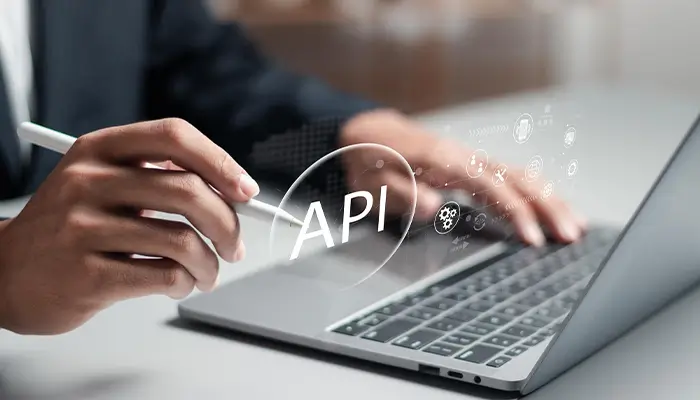
Sustainable Tech Design: How Green Computing Is Shaping Digital Creativity in 2025
November 17, 2025How API-first design is transforming web development into a faster, more scalable and platform-agnostic ecosystem.
The web as we know it is evolving, fast.
In an age of multi-device experiences, headless CMS and AI-powered systems, traditional “monolithic” websites can’t keep up.
Enter API-driven design, a modular, flexible approach to web development that powers everything from e-commerce apps to smart wearables and digital experiences across platforms.
In 2025, API-first architecture isn’t just a developer’s choice, it’s the foundation of scalable, secure and future-ready digital ecosystems.
-
What Is API-Driven (or API-First) Design?
An API (Application Programming Interface) acts as a bridge between different systems, allowing them to communicate and share data seamlessly.
In traditional websites, front-end (the design) and back-end (the logic) are tightly connected. With API-driven design, they are decoupled, meaning content, functionality and data are managed separately and integrated via APIs.
Example:
A headless WordPress setup delivers content through REST or GraphQL APIs, allowing developers to use any front-end framework, React, Next.js or Vue, to render the same data beautifully across web, mobile and IoT devices.
This modularity makes websites faster to build, easier to scale and simpler to maintain.

-
Why API-First Development Is the Future
In 2025, businesses need websites that are more than static pages, they need dynamic digital platforms capable of adapting to new technologies.
API-first design supports this by focusing on scalability, flexibility and integration from the ground up.
Core Advantages:
- Faster Development: Teams can build and test APIs before front-end development starts, accelerating production.
- Multi-Platform Compatibility: One API can serve websites, mobile apps and even smart devices simultaneously.
- Better Scalability: Add new features or front-end interfaces without rewriting your backend.
- Enhanced Security: APIs isolate key functions, limiting vulnerabilities and enabling better access control.
Insight:
According to Postman’s 2025 API Report, 89% of developers now adopt an API-first strategy, with companies reporting 36% faster release cycles and reduced infrastructure costs.
-
Modular Architecture: The Core of Modern Web Development
Think of API-driven design as LEGO blocks, each piece (authentication, payments, user data, analytics) is built independently and connected through APIs.
When you need to upgrade or replace one module, say, swap Stripe for PayPal or integrate a new AI chatbot, you can do it without breaking the whole system.
Example:
E-commerce platforms like Shopify Hydrogen, BigCommerce and Contentful use API-driven architectures to connect inventory systems, checkout flows and CMS data seamlessly across multiple platforms.
This modular structure means agility, the ability to evolve rapidly as technology changes.
-
API-Driven Design and Headless CMS
Headless CMSs like Contentful, Sanity and Strapi have made API-first design mainstream.
Instead of binding content to one website, headless CMSs store it centrally and deliver it through APIs to any platform, websites, mobile apps, voice assistants or digital billboards.
Example:
A single blog post stored in Contentful can appear simultaneously on:
- A WordPress website
- A mobile app
- An Apple Watch notification
- A LinkedIn carousel
All powered by the same API.
This approach ensures consistency in brand storytelling while reducing content duplication.
-
Performance and Speed: Lighter, Faster, Smarter
API-driven architecture directly contributes to faster load times and better SEO performance.
Because front-end systems fetch only the data they need, users experience faster page rendering and smoother interactions.
Tech Insight:
Frameworks like Next.js, Remix and Nuxt use APIs to pre-fetch data during build time or server-side rendering, drastically improving Core Web Vitals scores.
This lean, API-centered flow also integrates easily with Edge AI and CDN caching, ensuring global scalability and near-instant performance.
-
Security in API-Driven Systems
APIs can strengthen security when implemented correctly.
Modern API-first systems use:
- OAuth 2.0 & JWT for secure authentication.
- Rate limiting to prevent abuse.
- Zero-trust architectures that isolate endpoints.
Example:
Platforms like Auth0 and Okta provide API-driven identity management, protecting both web and mobile experiences with seamless, secure authentication flows.
This not only keeps data safer but also simplifies compliance with privacy laws like GDPR and CCPA.
-
Real-World Success Stories
- Netflix: Uses API-driven architecture to deliver content to TVs, mobile apps and browsers simultaneously, ensuring consistent performance across all devices.
- Airbnb: APIs power their modular platform, integrating booking systems, maps, payments and analytics from multiple services.
- Spotify: Uses APIs for personalized playlists, recommendations and real-time device syncing.
These examples highlight why API-first isn’t just a backend upgrade, it’s the blueprint of digital agility.
-
The Business Case for Going API-First
For agencies, startups and enterprises alike, adopting API-driven design means:
- Faster time to market.
- Easier integrations with third-party tools.
- Lower development costs over time.
- Consistency across multiple digital touchpoints.
According to Forrester (2025):
Organizations that embraced modular, API-driven architecture saw a 45% improvement in system uptime and 28% reduction in maintenance costs.
Conclusion
The web of 2025 is modular; scalable and interconnected and API-driven design is the engine powering it.
By building systems that are flexible, fast and secure, developers are creating websites that don’t just live online, they adapt, integrate and evolve across every digital channel.
In short, API-first architecture isn’t just the future of web development, it’s the foundation of a connected digital world.
If you have any questions regarding “API-Driven Design” feel free to contact us. For inquiries and consultations, call us at: +92 321 4808303 or Email us at: hello@owaisgilani.com.
Disclaimer: The information shared on this website is for educational and informational purposes only and reflects my personal views and experiences. While I strive to provide accurate and helpful content, readers should use their own judgment and consult with a qualified professional before making any decisions based on the information here. I am not responsible for any actions taken based on this content. Feel free to reach out to me if you need clarification or have questions before using any part of this information.



